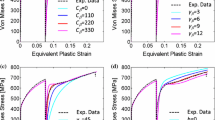Abstract
Using an exact solution for an elliptical hole in a perfectly plastic material, an expression is derived for the resistance of a ductile material undergoing subcritical crack propagation in the plane. This resistance curve is based on an analogy to the J-integral where an energy dissipation rate is determined rather than an energy release rate. The Tresca yield condition under plane stress loading conditions is employed in this derivation as well as finite deformation theory. This resistance curve is applicable to the initial stage of subcritical crack growth for a ductile material subject to crack tip blunting.



Similar content being viewed by others
References
Abramowitz M, Stegun IA (1964) Handbook of mathematical functions with formulas, graphs and mathematical tables. National Bureau of Standards, Series 55. U.S. Printing Office, Washington
ASTM Committee E 1820-1 (2002) Standard test method for measurement of fracture toughness. Annual book of ASTM standards, vol 03.01. ASTM, West Conshohocken, pp 1031–1076
Byrd PF, Friedman MD (1971) Handbook of elliptic integrals for engineers and scientists, 2nd edn. Springer, New York
Gradshteyn IS, Ryzhik IM (1980) Table of integrals, series, and products. Integral entry 2.513–13 Academic Press, Orlando, p 132
Hertzberg RW (1996) Deformation and fracture mechanics of engineering materials, 4th edn. Wiley, Hoboken, p 366
Rice JR (1968) A path independent integral and approximate analysis of strain concentrations by notches and cracks. J Appl Mech 35:379–386
Unger DJ (2005) Perfectly plastic caustics for the opening mode of fracture. Theor Appl Fract Mech 44:82–94
Unger DJ (2008) Path independent integral for an elliptical hole in a plate under tension for plane stress deformation theory. J Elast 92:217–226
Unger DJ (2010) Large plastic deformations accompanying the growth of an elliptical hole in a thin plate. J Elast 99:117–130
Unger DJ (2011) Analytical fracture mechanics. Dover Publications, Mineola
Unger DJ (2016a) Path-dependent J-integral evaluations around an elliptical hole for large deformation theory. J Mech Behav Mater 25:77–81
Unger DJ (2016b) Erratum to: clarification of terminology used in: path-dependent J-integral evaluations around an elliptical hole for large deformation theory. J Mech Behav Mater 25:189
Author information
Authors and Affiliations
Corresponding author
Rights and permissions
About this article
Cite this article
Unger, D.J. A theoretical resistance-curve based on nonproportional plastic strain. Int J Fract 210, 207–211 (2018). https://doi.org/10.1007/s10704-018-0272-0
Received:
Accepted:
Published:
Issue Date:
DOI: https://doi.org/10.1007/s10704-018-0272-0




